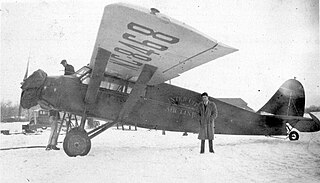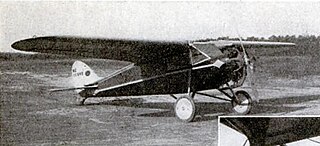
The Lockheed Vega is an American six-passenger high-wing monoplane airliner built by the Lockheed Corporation starting in 1927. It became famous for its use by a number of record-breaking pilots who were attracted to the rugged and very long-range design. Amelia Earhart became the first woman to fly solo across the Atlantic Ocean in one, and Wiley Post used his to prove the existence of the jet stream after having flown around the world twice.

Clyde Vernon Cessna was an American aircraft designer, aviator, and early aviation entrepreneur. He is best known as the principal founder of the Cessna Aircraft Corporation.

Thomas Foster Hamilton was a pioneering aviator and the founder of the Hamilton Standard Company.

Blériot Aéronautique was a French aircraft manufacturer founded by Louis Blériot. It also made a few motorcycles between 1921 and 1922 and cyclecars during the 1920s.
Berliner-Joyce Aircraft was an American aircraft manufacturer. It was founded on 4 February 1929 when Henry Berliner and his 1922 company, Berliner Aircraft Company of Alexandria, Virginia, joined with Maryland Aviation Commission leader Captain Temple Nach Joyce.

The Stinson Detroiter was a six-seat cabin airliner for passengers or freight designed and built by the Stinson Aircraft Syndicate, later the Stinson Aircraft Corporation. Two distinct designs used the Detroiter name, a biplane and a monoplane.

Maryland's first aeronautical event was the flight of 13-year-old Edward Warren from Baltimore in Peter Carne's tethered hot air balloon in 1784.

The Burnelli CB-16, also known as the Uppercu-Burnelli CB-300, was a passenger aircraft designed by the American company Burnelli in 1928. It was the first twin-engined aircraft to have retractable landing gear and the first to maintain altitude on only one out of two engines. Only one was built.
Davis Aircraft Corporation was an American aircraft manufacturer.
Vulcan Aircraft Corporation was an American aircraft manufacturer.

The Doyle Aero O-2 Oriole or Doyle O-2 was a parasol wing aircraft.

The Vulcan American Moth Monoplane was an early parasol-wing monoplane developed by the Doyle brothers.

The Lindbergh Boom (1927–1929) is a period of rapid interest in aviation following the awarding of the Orteig Prize to Charles Lindbergh for his 1927 non-stop solo transatlantic flight in the Spirit of St. Louis. The Lindbergh Boom occurred during the interwar period between World War I and World War II, where aviation development was fueled by commercial interests rather than wartime necessity. During this period, dozens of companies were formed to create airlines, and aircraft for a new age in aviation. Many of the fledgling companies funded by stock went under as quick as they started as the stock that capitalized them plummeted in value following the Wall Street Crash of 1929. The Great Depression dried up the market for new aircraft, causing many aircraft companies to go into bankruptcy or get consolidated by larger entities. Air racing, record attempts, and barnstorming remained popular, as aviators tried to recapture the prizes and publicity of Lindbergh's Transatlantic flight.

The Texas Aero Corporation of Temple, Texas was formed about 1927 to construct passenger and mail light aircraft. The company's origin can be traced back to George W Williams Texas Aero Manufacturing Company of 1911.
Swen (Sven) Swanson was a Swedish aircraft designer. He designed aircraft for various aviation companies in the United States and also designed prototype and experimental airplanes. He was known as an innovative aircraft designer. He later worked in partnership with Ole Fahlin. Swanson started designing airplanes while in his teens and by the time he was in college he had designed his third airplane. He founded the Swanson Aircraft Company Inc. and became its chief engineer and president. While working for his own company he designed and built the Swanson W-15 Coupe. He has been described as a "brilliant man of great capabilities and extreme modesty".

The Swanson Coupe Model W-15 was a high-wing, cantilever-type monoplane produced in 1931 by Swedish aircraft designer and manufacturer Swen Swanson. Its design was considered innovative and the aircraft was viewed as part of a trend of producing safe and economical airplanes, which would appeal especially to automobile drivers. The Swanson Coupe was also designed to function as trainer aircraft.












